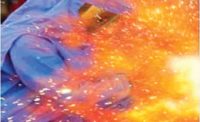Selecting PPE for arc flash protection
Two ways to choose

 Four different arc flash type events need to be assessed when designing safety programs:
Four different arc flash type events need to be assessed when designing safety programs:
- Open Air Arc Flashes
- Ejected Arc Flashes
- Equipment Focused Arc Flashes (Arc-in-a-box)
- Tracking Arc Flashes
Many methods exist to protect personnel from arc flash hazards. This can include workers wearing arc flash personal protective equipment (PPE), or modifying the design and configuration of electrical equipment.
The best way to remove the hazards of an arc flash is to de-energize electrical equipment when interacting with it. But de-energizing electrical equipment is itself an arc flash hazard. One of the newest solutions is to allow the operator to stand far back from the electrical equipment by operating equipment remotely. This is called remote racking.
Many companies offer arc flash personal protective equipment (PPE). Materials are tested for their arc rating. The arc rating is the maximum incident energy resistance demonstrated by a material prior to breakopen (a hole in the material) or necessary to pass through and cause with 50% probability a second or third degree burn.
Arc rating is normally expressed in cal/cm² (or small calories of heat energy per square centimeter). The tests for determining arc rating are defined in ASTM F1506 Standard Performance Specification for Flame Resistant Textile Materials for Wearing Apparel for Use by Electrical Workers Exposed to Momentary Electric Arc and Related Thermal Hazards.
Selecting the right PPE, given a certain task to be performed, is normally handled in one of two ways. The first is to consult a hazard category classification table, like that found in NFPA 70E. Table 130.7(C)(15)(a) lists a number of typical electrical tasks by various voltage levels and recommends the category of PPE that should be worn.
For example, when working on 600 V switchgear and performing a removal of bolted covers to expose bare, energized parts, the table recommends a Category 3 Protective Clothing System. This Category 3 system corresponds to an ensemble of PPE that together offers protection up to 25 cal/cm² (105 J/cm² or 1.05 MJ/m²). The minimum rating of PPE necessary for any category is the maximum available energy for that category. For example, a Category 3 arc-flash hazard requires PPE rated for no less than 25 cal/cm² (1.05 MJ/m²).
The second method is to perform an arc flash hazard calculation to determine the available incident arc energy. IEEE 1584 provides a guide to perform these calculations given that the maximum fault current, duration of faults, and other general equipment information is known. Once the incident energy is calculated the appropriate ensemble of PPE that offers protection greater than the energy available can be selected.
PPE provides protection after an arc flash incident has occurred. It should be viewed as the last line of defense. Reducing the frequency and severity of incidents should be the first option and this can be achieved through a complete arc flash hazard assessment and through the application of technology such as high-resistance grounding which has been proven to reduce the frequency and severity of incidents.
Looking for a reprint of this article?
From high-res PDFs to custom plaques, order your copy today!







